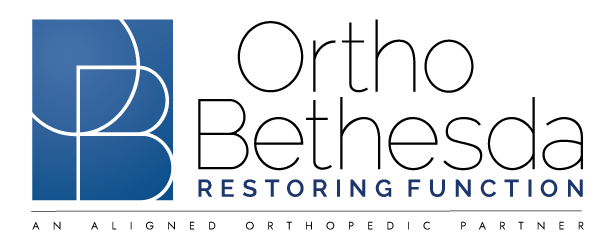
More and more people around the U.S. are participating in sports. Baseball, one of America’s favorite pastimes, saw a 21% increase in participation from 2014 to 2018. According to the Sports and Fitness Industry Association, more than 15.5 million played baseball as of last year. Additionally, nearly half of all core participants were in 8th grade or younger.
Increased sports participation means more healthy physical activity, but it could also mean more injuries. In throwing sports specifically, like baseball, athletes run the risk of tearing their ulnar collateral ligament. Fortunately, athletes can correct this issue with Tommy John Surgery.
Who Tommy John Is
Thomas Edward John, better known to people as Tommy John, was a Major League Baseball pitcher. He was born on September 6, 1943, in Indiana and attended high school there. His dad was his only coach before he turned 16, and he made his Major League Baseball debut on September 6, 1963, at just 20 years old.
From 1963 to his retirement 26 years later in 1989, Tommy John played for various Major League Baseball teams — the Indians, the White Sox, the LA Dodgers, the Yankees, the California Angels, the Oakland Athletics and back to the Yankees before retiring.
However, Tommy John experienced a minor setback in his career in 1974 when he suffered a damaged ligament in his elbow. Tommy underwent a never-before-performed surgery that September to repair his ulnar collateral ligament. The operation proved to be successful in saving his pitching arm and his baseball career. He was back in spring training with the Dodgers in 1975 but wasn’t pitching just yet.
Tommy John started pitching full-time again for the Dodgers in 1976 and went on to play in the World Series multiple times. Tommy won the AL All-Star, the NL All-Star, the NL Player of the Month, the Hutch Award and the Lou Gehrig Award.
What Tommy John Surgery Is
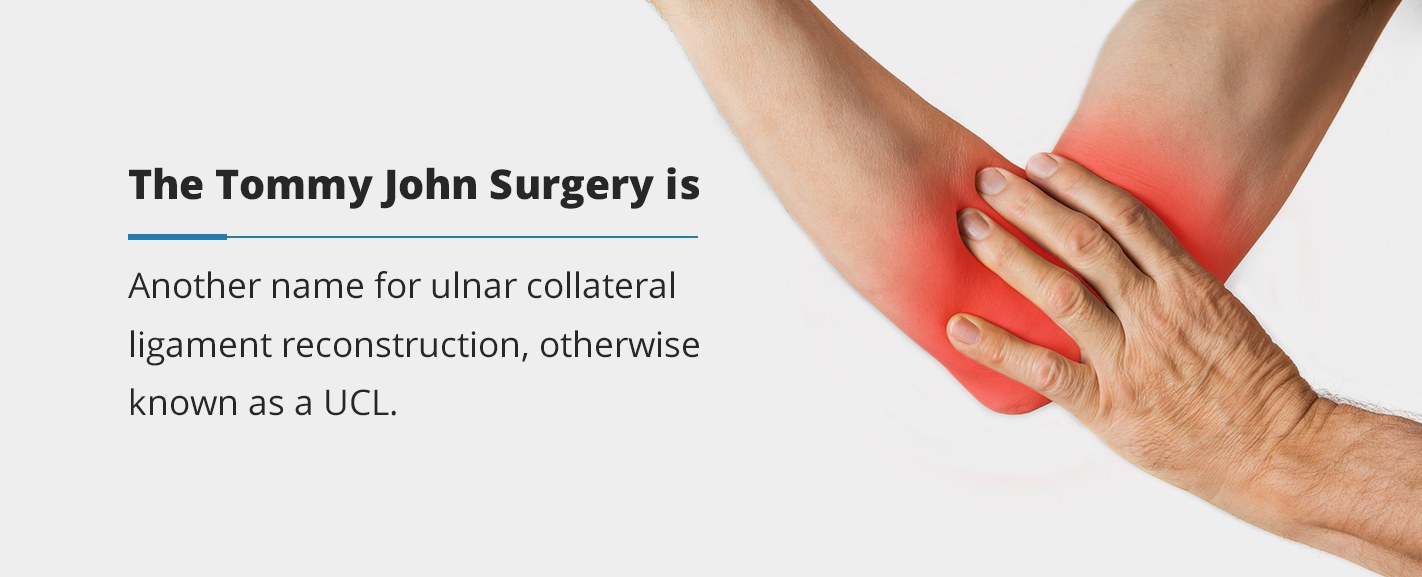
Now you know who Tommy John is, but what, exactly, is Tommy John Surgery? Tommy John Surgery is another name for ulnar collateral ligament reconstruction. Doctors perform this procedure to fix an ulnar collateral ligament, otherwise known as a UCL, in the elbow if it’s torn — which begs the next question: What is a UCL?
The UCL is found on the inner part of the elbow, and it works to keep your elbow joint in place. It’s essential for stability. It also works with the lateral collateral ligament in the arm to connect the humerus — the long bone in the upper arm — to the ulna in the forearm. However, with constant throwing motions in sports, for example, the UCL in the arm can tear. Fortunately, Tommy John Surgery can help.
The surgery, first performed by Dr. Frank Jobe on Tommy John, usually requires a UCL replacement. For this replacement, doctors take a tendon from somewhere else in the body or from a donor’s body to act as the new UCL. This surgery is for torn UCLs as a result of overuse, common in many athletes, and is less for those who suffer a tear from one traumatic event.
Ultimately, Tommy John Surgery works to eliminate or reduce pain, keep the elbow intact and help people get their range of motion and stability back so that they can get back to doing the things they enjoy.
Why It’s Called Tommy John Surgery
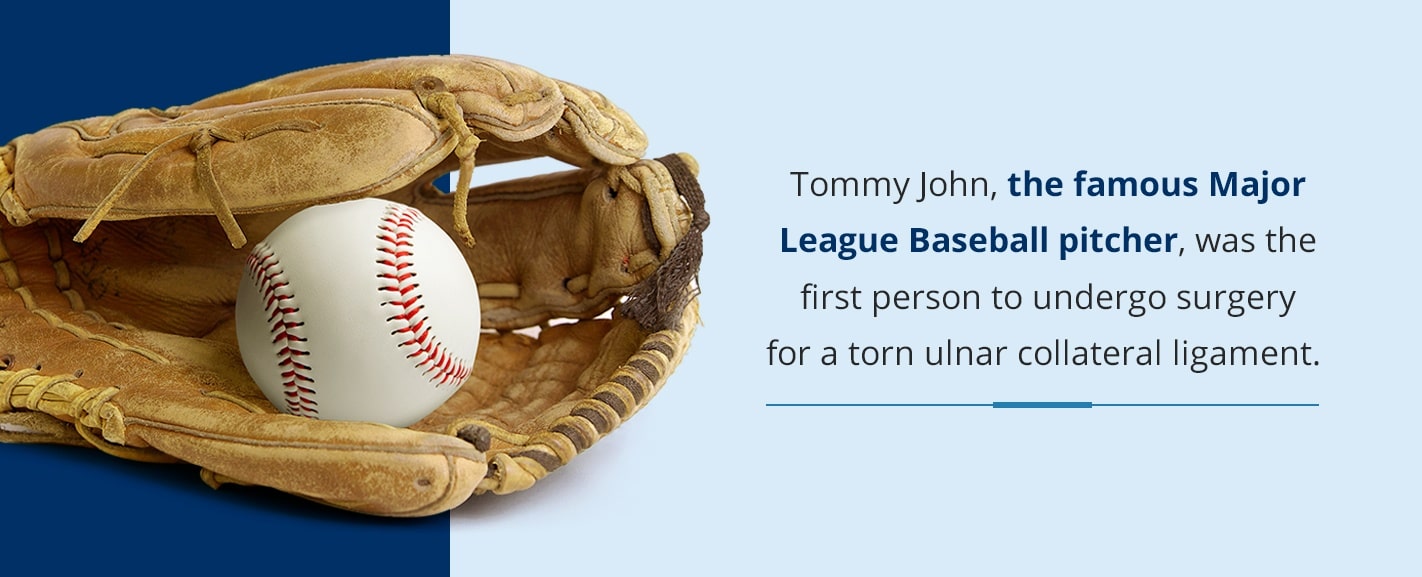
Tommy John Surgery is named after none other than Tommy John himself, the famous Major League Baseball pitcher who was the first person to undergo surgery for a torn ulnar collateral ligament. Since UCL reconstruction surgery is so popular specifically among baseball players, it’s fitting that the surgery is named after one.
What does Tommy John think about the namesake surgery? He believes it’s become much too common today. While he acknowledges the surgery as saving many professional careers — more than 500 Major League Baseball players have gotten the surgery — he isn’t in favor of the mass influx of children receiving the operation.
Tommy John Surgery has climbed in popularity among MLB players, growing from 12 surgeries in 1974 to 1994 and 22 from 1995 to 1999 to 194 performed on MLB players from 2000 to 2011. During those 11 years, 275 Minor League players had the operation. Just five years ago, in 2014, 19 Tommy John surgeries were performed by May, before the season even reached the halfway mark. Today’s sports world is putting more pressure on children than before, and it’s showing through bodily injuries.
From 2007 to 2011, Tommy John Surgery performed on 15- to 19-year-old players increased nine percent. The American Journal of Sports Medicine reports that nearly 57% of all Tommy John surgeries from 2007 to 2011 were performed on 15- to 19-year-olds. Additionally, adolescent pitchers, ages 14 to 20, who had the operation were 36 times more likely to have repeatedly pitched while experiencing arm fatigue.
Another risk factor is the amount the young players are pitching, as longer seasons and more practice can have an impact on the rates of bodily injury. In another study of 45 high school/college-level players and 169 MLB players, more than half of the players who suffered a UCL injury had previously suffered elbow injuries when they were children.
What Is the Cause of the Need for Tommy John Surgery?
Tommy John Surgery is another name for UCL reconstruction, so if you’re wondering what causes the need for Tommy John Surgery, look no further than a torn ulnar collateral ligament. As mentioned, torn UCLs are usually the result of throwing sports, like baseball, tennis, javelin throw, softball or football, for example. However, they can also occur following elbow dislocation or surgery.
Throwers are most at risk for UCL tears, as they put constant stress on the ligament bending and twisting the elbow. Plus, the rise of youth sports and increased average velocities are two main attributing factors to increased UCL injuries.
More kids today are choosing one sport to specialize in and practice all year to build their skills. This change means that aspiring baseball players could be causing severe damage to their arm from repeated stress. Since their arm never catches a break, it may result in an injury. Pitchers are also pitching faster than before, straining their arm and UCL. Couple that with poor mechanics, and you have a recipe for a necessary Tommy John procedure.
Your UCL could also develop microtears, otherwise known as small muscle tears, over time. This development causes the ligament to stretch out and fray and leads to ligament ruptures. Once the ligament stretches, it can’t hold the bones anymore while throwing. You also risk tearing your elbow’s ulnar collateral ligament if you fall on an outstretched hand.
After a UCL is torn, it usually won’t heal on its own. There are three main sprain grades when it comes to a torn UCL — first degree, second degree and third degree:
- First degree: This issue is painful, but the ligament is not lengthened.
- Second degree: The ligament still works but is stretched.
- Third degree: The ligament has torn and does not function.
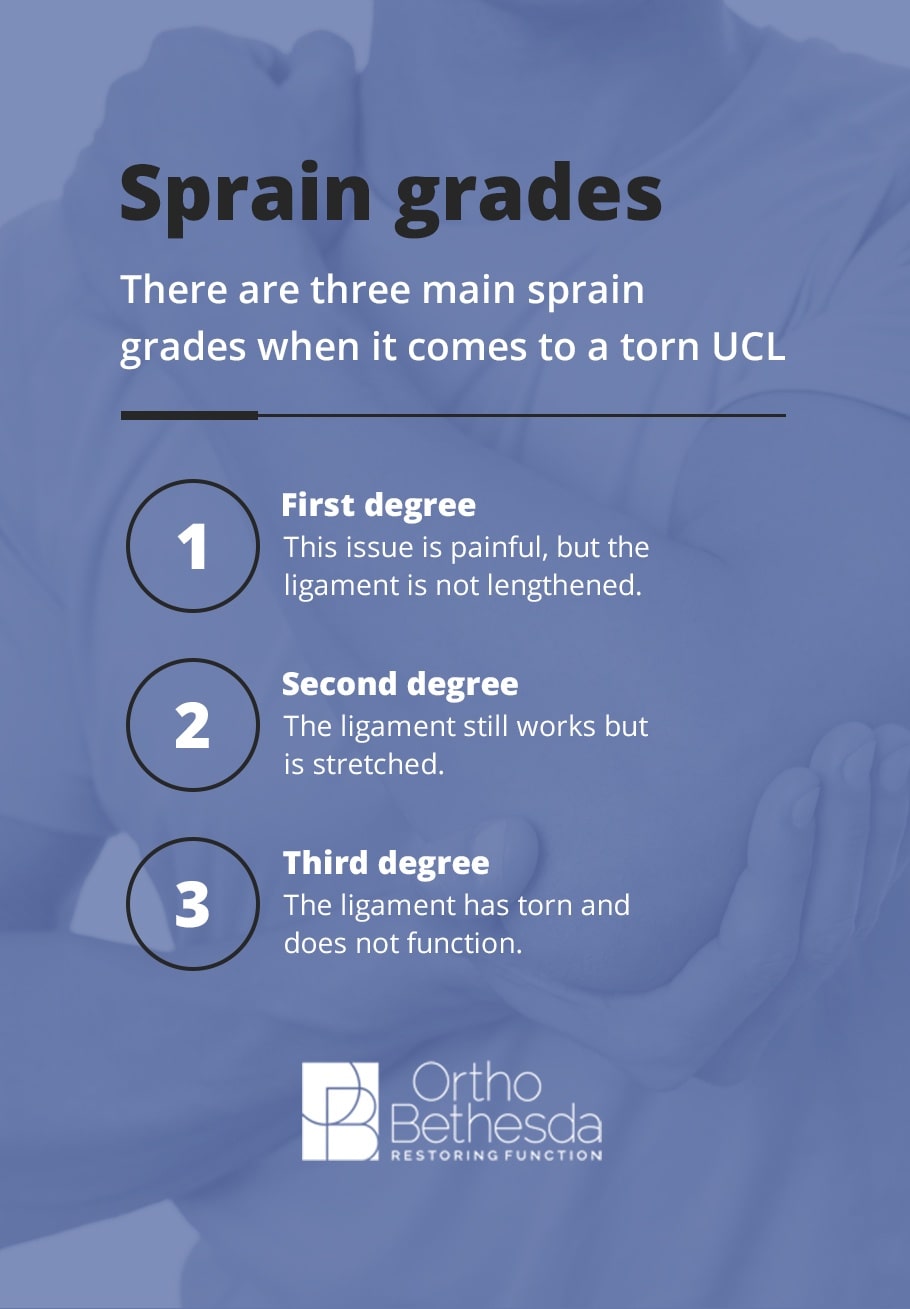
Many doctors will recommend physical therapy or other alternatives before resorting to surgery. However, for athletes who want to get back in the game or for anyone experiencing chronic pain or instability in the elbow, Tommy John Surgery is the best option.
What Ulnar Collateral Ligament Reconstruction Is
Ulnar collateral ligament reconstruction, also known as Tommy John Surgery, is the process of fixing your torn UCL by replacing it with a tendon from somewhere else in your body. It helps alleviate pain and get your elbow back in stable condition so that you can get back to doing the things you love.
Sports medicine experts and orthopedic specialists typically diagnose these injuries through a history and physical exam, but they may also use X-rays or MRI scans. After recognizing symptoms and seeking medical attention, you may undergo ulnar collateral ligament reconstruction.
Symptoms
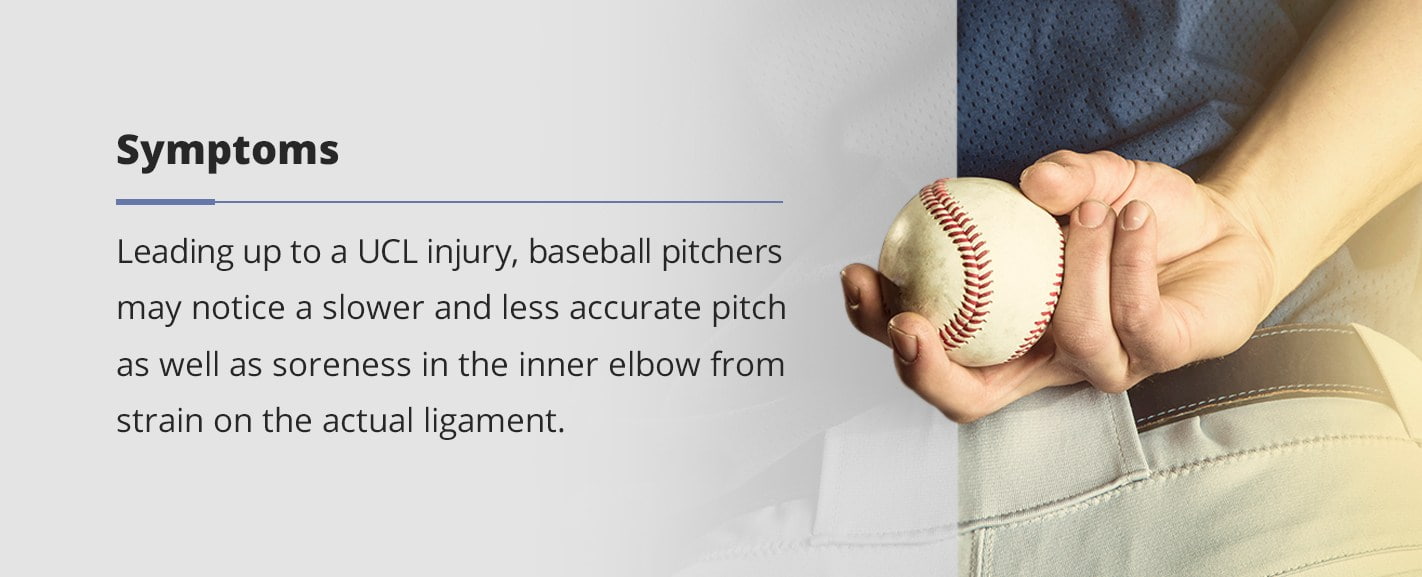
If you’re an avid athlete, it’s crucial for you to know the difference between a sore arm and an elbow injury like a torn UCL. That way, you can prevent any further damage. While these injuries are instantly apparent in some cases, UCL tears don’t usually interfere with daily activities that don’t require throwing. Leading up to a UCL injury, baseball pitchers may notice a slower and less accurate pitch as well as soreness in the inner elbow from strain on the actual ligament.
It’s essential to treat your UCL injury, so make sure you recognize the signs and consider the following symptoms:
- An audible “popping” sound
- A numbness or tingling sensation in the pinky, ring finger and/or hand
- Inability to throw or move the arm at all
- Swelling on the inside part of the elbow and forearm
- Tenderness along the inside of the elbow
- Bruising around the injury site
- Elbow stiffness or inability to straighten the elbow
- A very weak or clumsy hand grip
In a study of 21 baseball players who underwent Tommy John Surgery, it took five months on average from the time of first noticing symptoms to getting the surgery. During this time, doctors gave players other methods to try as they usually do before resorting to surgery. These other options were rest, physical therapy and an interval throwing program. However, these processes weren’t enough for the players in the study, who still had to undergo UCL reconstruction.
Procedure
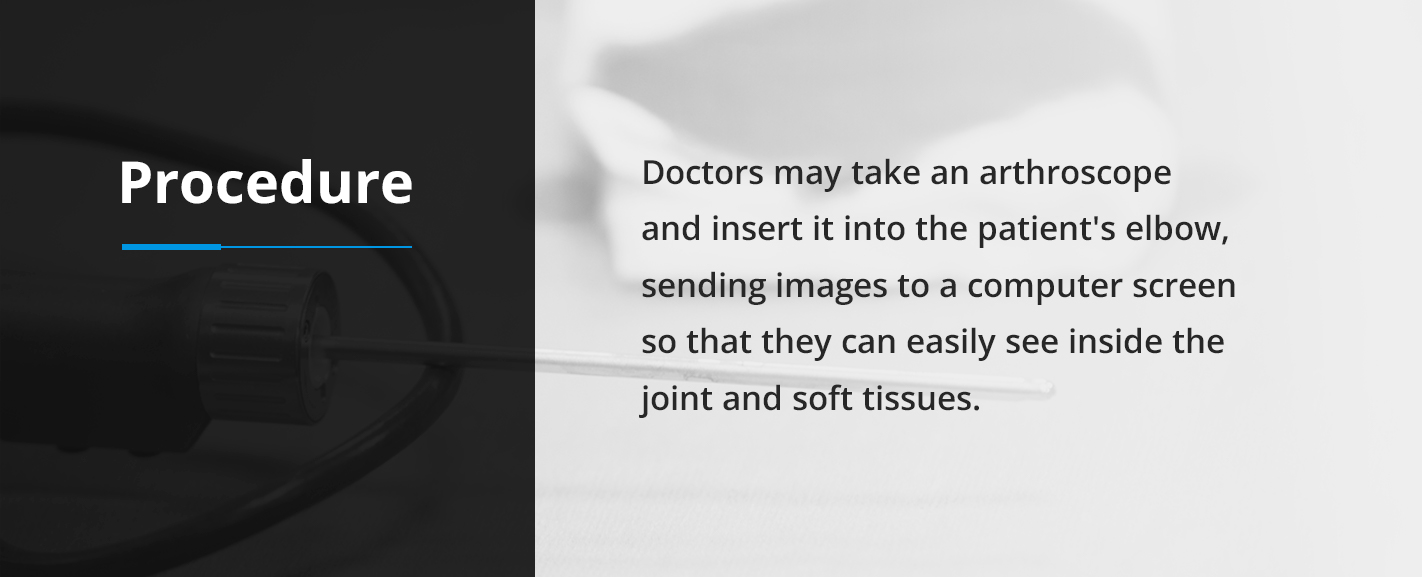
Ulnar collateral ligament reconstruction is typically an outpatient procedure that lasts only an hour to an hour and a half. Patients undergo surgery after other rehabilitation exercises, rest or medications fail to yield significant results. Doctors administer general anesthesia before the procedure so that patients won’t feel anything during the surgery. Sometimes doctors can perform arthroscopic UCL reconstruction.
Arthroscopes are tools that have small fiber-optic TV cameras. Doctors may take an arthroscope and insert it into the patient’s elbow, sending images to a computer screen so that they can easily see inside the joint and soft tissues. The doctor may also get rid of any dead or injured tissue and smooth out rough edges during the surgery. However, many times, patients must undergo an open incision Tommy John Surgery to correct their injury.
When your ligament pulls away from your bone, the doctor must replace your damaged UCL with a tendon from somewhere else. They may take a tendon, called a graft, from somewhere else in your body or from a donor. These grafts are usually taken from the hamstring tendon, the tendon in the forearm or the big toe extensor tendon.
The doctor will make an incision, typically three to four inches long, on the outside of the elbow and move tissue and muscles to get to the damage. They’ll then take out damaged tissue and sometimes put what’s left of the original ligament with the new graft to keep the structure super sturdy.
To put the new tendon in, the doctor will drill holes in the upper arm bone, or humerus, and the lower arm bone, the ulna — the bones connected by the UCL. After they drill holes, they’ll thread the graft tendon through the holes using techniques like docking and secure them with sutures, screws or buttons.
Benefits of the Surgery
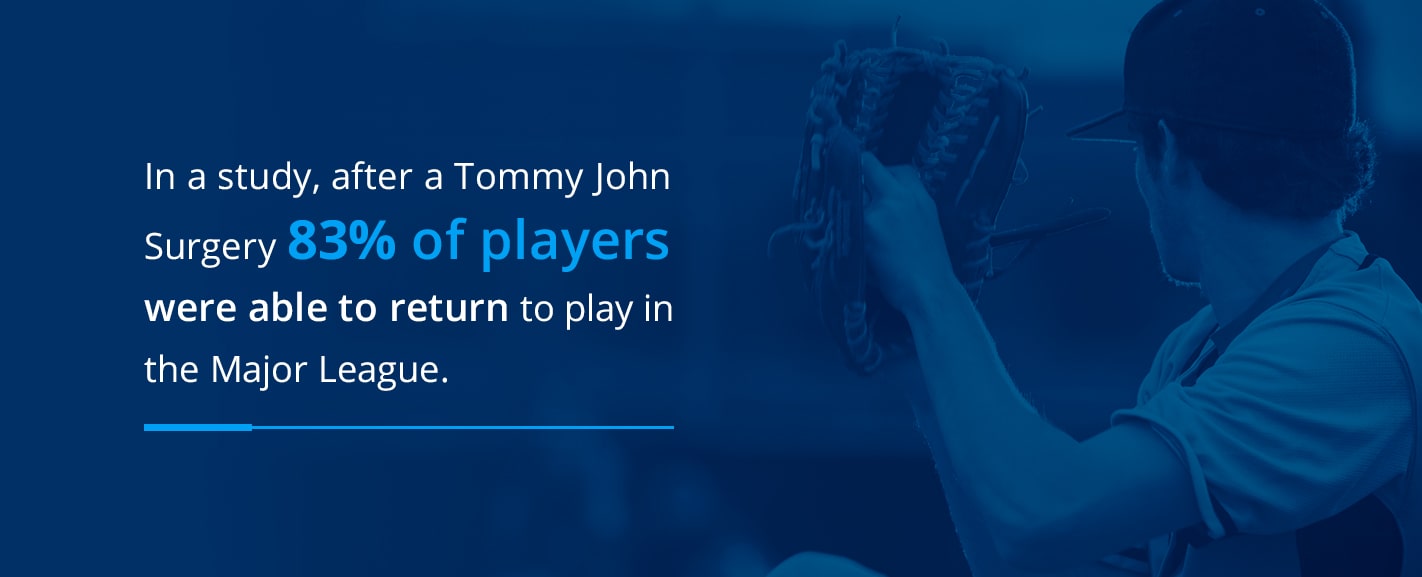
For many athletes who experience UCL tears, the most significant advantage of Tommy John Surgery is the ability to get back in the game. Just as the surgery worked and extended Tommy John’s baseball career, it can also help other athletes continue their sports careers if they follow their doctor’s advice, practice physical therapy and avoid rushing recovery.
In a study of 179 Major League Baseball pitchers who suffered UCL tears and had Tommy John Surgery, 148 players, or 83%, were able to return to play in the Major League. Additionally, 174 pitchers could return to play in the major and minor leagues combined. Only five pitchers, 2.8%, couldn’t return to play in either league.
Tommy John Surgery has encouraging return to sports (RTS) rates (sometimes also referred to as return to play or RTP rates), at more than 80% following the surgery. However, the RTS rate after revision Tommy John Surgery isn’t as high, so you may not experience the same results if it’s not your first UCL reconstruction.
It’s challenging to give an exact time frame for how long the results of Tommy John Surgery lasts, as it ultimately varies person to person depending on their specific injury. For some players, once is enough to get them through their sports career, while other players might undergo revision surgeries. Even without sports in the mix, Tommy John Surgery is still extremely beneficial since it alleviates pain and restores the UCL to working properly again.
Risks of the Surgery
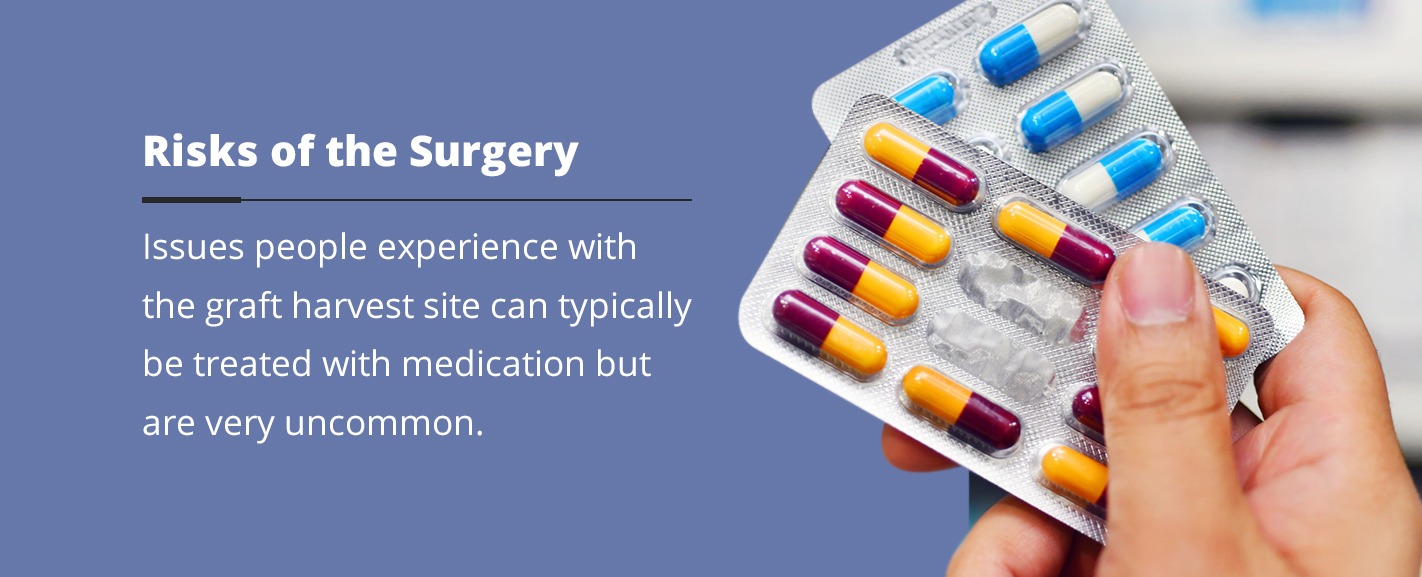
Although the Tommy John procedure is relatively quick and straightforward, there are still risks involved as with any surgery. According to the National Institute of Health, patient selection and previous operations could impact complications, and complication rates for the surgery generally range from 8.8 to 40%. Since doctors administer general anesthesia for the surgery, there’s always a slight risk even though many recognize anesthesia as being very safe. Make sure you prepare per the doctor’s instructions before you go under. This often includes no eating or drinking for a number of hours before the surgery.
UCL surgery also presents the risk of infection following the procedure. Patients may suffer damage to their nerves and blood vessels if they have complications. The graft used in the surgery could also stretch or rupture, which may require a second reconstruction with a new graft put in. Reoperation makes up about two percent of surgery complications.
Some may also experience pain at the graft harvest site or paresthesias — itchiness, numbness or a pins-and-needles sensation — which accounts for about four percent of complications. Issues people experience with the graft harvest site can typically be treated with medication but are very uncommon.
This surgery can also irritate the ulnar nerve since the UCL site is in the same area where the nerve goes around the elbow joint. The doctor may need to move it in front of the elbow joint to prevent ulnar neuropathy. Just over a quarter of complications are from ulnar neuropathy at 26%, which results in tingling and numbness. Sometimes patients may experience weakness and numbness, which could be temporary or permanent.
Elbow stiffness makes up 13% of complications, while synovitis, or swelling around the elbow joint, makes up seven percent. Not as much a risk, but patients will also bear a surgical scar that will remain. For many who go on to find success after Tommy John Surgery, the benefits greatly outweigh the potential risks.
Recovery and Recovery Time
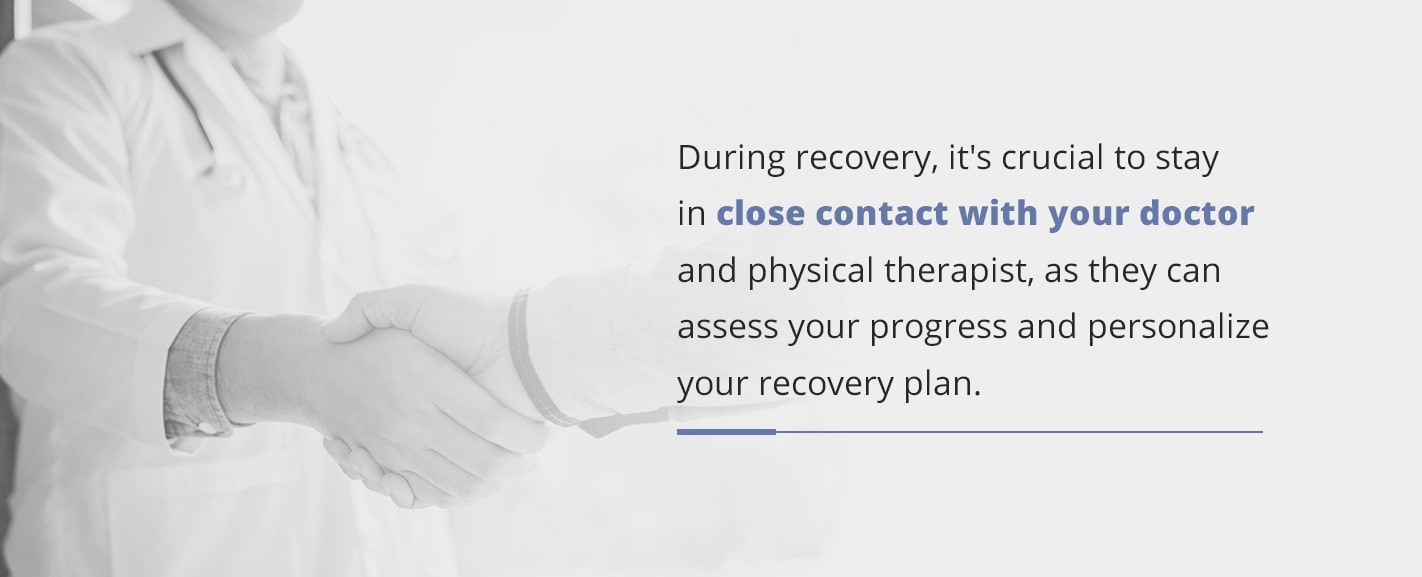
Since people may heal differently, it can be challenging to pinpoint an exact Tommy John Surgery recovery time. Some places say athletes should wait six to nine months before returning to competitive throwing and nine months to a year before actually competing again. Generally, it’s safe to say most UCL reconstruction recoveries take about a year, although some athletes need up to two years to get back to the level they were at before the surgery.
During recovery, it’s crucial to stay in close contact with your doctor and physical therapist, as they can assess your progress and personalize your recovery plan. However, you can think of Tommy John Surgery recovery in four main phases, which follow.
Phase One
- This period is from immediately after the surgery until week three.
- Elbow movement is restricted during the first week after surgery.
- The elbow is in an angled brace to help keep inflammation down and protect the tissue.
- It’s okay to start physical therapy on the wrist, fingers, shoulder and biceps to prevent muscle atrophy.
- You can start gently moving your elbow in week two.
- You should focus on your range of motion and moving your elbow more and more each week.
Phase Two
- This period takes place from weeks four through eight.
- The phase focuses on building back strength.
- You can take the brace off around week six.
- You should be able to extend the elbow fully.
- Start exercising with one-pound weights, and increase the weight an additional pound each week.
- Exercises will help the elbow, shoulder and scapular stabilizers in recovery.
Phase Three
- Phase three is weeks nine through 13.
- This period aims to get back a broader range of movement and function in the arm.
- Focus on flexibility.
- Start new exercises.
- Begin a more intensive muscular exercise program at 12 weeks and emphasize proper throwing mechanics.
Phase Four
- Phase four is weeks 14 to 26.
- This phase focuses specifically on throwing again.
- Start throwing just 45 feet, but make your way up to long toss throws.
- The last step is to throw from the mound and simulate actual gameplay before competing.
- It will likely take 10 to 18 months before you can throw in a game again.
Trust OrthoBethesda for Tommy John Surgery on Your Torn UCL

If you’ve noticed you’re not pitching like you used to or are experiencing elbow pain or discomfort, you might have a torn UCL. OrthoBethesda can help. For more than 50 years, we’ve provided exceptional orthopedic treatment to our customers in Bethesda, Maryland, and Arlington, Virginia.
You probably have questions, and our caring, compassionate team has the expertise to answer them so that you can feel right at home. At OrthoBethesda, your care is our top priority. We understand how detrimental a torn UCL can be on your sports career, which is why we’ll look at all available options, including Tommy John Surgery, so that you can get on the path to recovery. Contact OrthoBethesda today to take steps toward getting back out on the field.
Related Content
- Golfer’s Elbow: What Is Is and How You Can Heal It
- What’s the Difference Between Golfers Elbow and Tennis Elbow
- 7 Tennis Elbow Exercises to Treat Your Pain at Home
- How Long It Takes for Tennis Elbow to Heal
- Top Exercises to Avoid If You Have Tennis Elbow
- Exercises You Can Do for Tennis Elbow
- Biceps Tendonitis
- Tenodesis vs. Tenotomy
